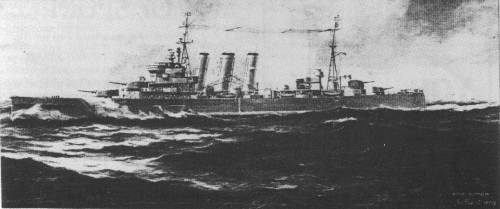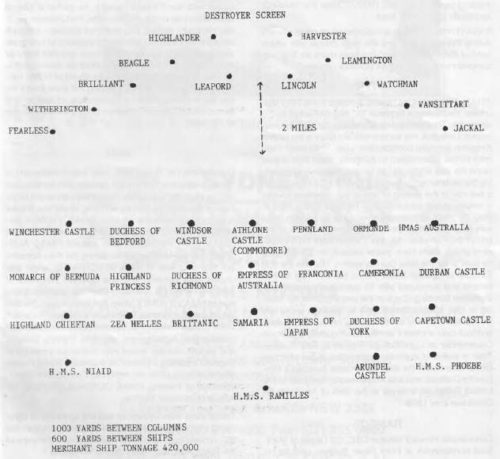- Author
- Gregory, Mackenzie J.
- Subjects
- WWII operations
- Tags
-
- RAN Ships
- HMAS Australia II
- Publication
- September 1995 edition of the Naval Historical Review (all rights reserved)

In January 1941, I was serving in the County Class Cruiser “Australia” as a Midshipman, having joined the ship in September 1939 just after the outbreak of war.
We had already operated in the Atlantic since July 1940.
On Monday, January 6th, 1941 we undocked from the Canada graving dock at Liverpool, having had a new port outer propeller fitted.
The weather was extremely cold and an influenza epidemic was sweeping through the ship’s company. The next day we sailed with a convoy, anchoring in Moelfre Bay off the North East of the Island of Anglesey, Wales.
Whilst at anchor, destroyers maintained a continual antisubmarine sweep and Hurricane aircraft from the RAF kept up a constant air patrol to deter any enemy aircraft attack. The cruiser “NIAID” joined us on Wednesday and we fuelled destroyers “HARVESTER” and “HIGHLANDER” astern.
At 2100 on Friday 10th January we weighed anchor, took up station astern of the convoy Port Column and proceeded to Belfast Lough where we anchored next morning.
Sunday the 12th we weighed and sailed with our convoy for the Clyde Scotland and there joined the largest convoy ever to leave from the British Isles – (The ships’ tonnage added up to 420,000 tons).
We sailed westerly until reaching longitude 24 degrees West, when the convoy turned South.
On the morning of Wednesday 15th January 1941, four of our destroyer escorts left us and later in the day “NIAID” and “PHOEBE” with the “CAPE TOWN CASTLE” and “DUCHESS OF BERMUDA” parted company.
We were joined by the old cruiser “EMERALD” and by the next day, all of our destroyer escorts had left, and on Friday the 17th “RAMILLES” with the “DUCHESS OF YORK” parted company.
Up to this stage of our voyage, we had enjoyed the company of a quite formidable escort – now with only “EMERALD” for company with the “AUSTRALIA”, I am sure our large convoy of Merchant ships suddenly felt quite naked.
We had passed through the dangerous submarine infested waters without an attack developing, it appears providing one has a strong escort, particularly including numbers of destroyers, that it acts as a sufficient deterrent. The “BRITANNIC” dropped out of the convoy, a broken lubricating oil line being the cause. “AUSTRALIA” circled around her until repairs could be effected and she regained her convoy position.
On Sunday 19th January, it was learned that the tanker “BRITISH UNION” had been sunk by a raider, 200 miles south of us.
The armed Merchant cruiser “ARAWA” in the vicinity picked up one of the tanker’s boats and is searching for other survivors.
On Monday the 20th, corvettes “ASPIDEL” and “CALENDULA” joined us as the anti-submarine screen together with the destroyer “VELOX”.
During this afternoon the Merchantman, “CLAN BUCHANAN” was identified. The method used is “AUSTRALIA” challenges with N.N.J. meaning, what are your signal letters? The Merchant ship should alter course away and reply with their signal letters, we now look up their secret signal letters which constitute a four letter group. The challenging warship sends back the two centre letters and the challenged ship should respond with the two outer letters.
Identification is then correct and completed. We continued our convoy towards the bulge of West Africa and it is estimated that we will arrive at Freetown by next Saturday the 25th January. The two more ships joined the close screen, the corvette “CLEMATIS” and the destroyer “VIDETTE”.
On the 27th January the convoy cleared Freetown en route to the Cape of Good Hope and Capetown. Half the convoy parted company to enter Capetown.
“AUSTRALIA” continued with the other half, setting course for Durban.
Sunday 9th February 1941, my 19th birthday, still at sea and a long way from home. We finally shepherded our half of the convoy into Durban Harbour on February 16th, our long journey of 5 weeks was finally over, all the ships that commenced this voyage finally arrived safely at their destination. Once again that expression, “the speed of the convoy is the speed of the slowest ship” had once more been proven.





